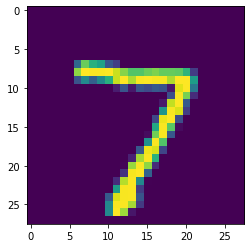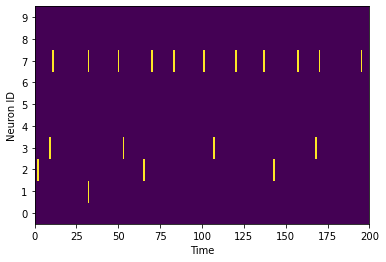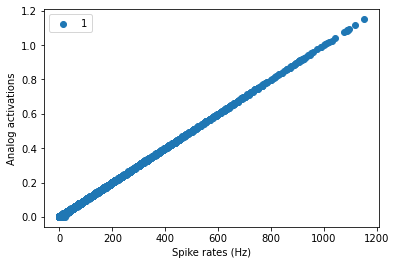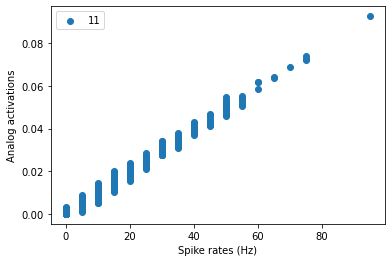MNIST Example
This tutorial walks you through the different steps involved in building a spiking neural network in sinabs.
Lets start by installing all the necessary packages.
[5]:
# To keep this tutorial clean and succint, we are directing the output of the `pip` command to a file `install_log`.
# You might want to get rid of the output redirection if you want to make sure there are no errors.
# %pip install -r mnist-requirements.txt
%pip install -r mnist-requirements.txt > install_log
Note: you may need to restart the kernel to use updated packages.
Training a model in sinabs
Define a PyTorch Model
sinabs is a PyTorch-based library so we start by simply defining our model in PyTorch. In this example we instantiate a nn.Sequential model with 3 Conv2d layers and two dense (nn.Linear) layers.
[6]:
import torch.nn as nn
ann = nn.Sequential(
nn.Conv2d(1, 20, 5, 1, bias=False),
nn.ReLU(),
nn.AvgPool2d(2,2),
nn.Conv2d(20, 32, 5, 1, bias=False),
nn.ReLU(),
nn.AvgPool2d(2,2),
nn.Conv2d(32, 128, 3, 1, bias=False),
nn.ReLU(),
nn.AvgPool2d(2,2),
nn.Flatten(),
nn.Linear(128, 500, bias=False),
nn.ReLU(),
nn.Linear(500, 10, bias=False),
)
Define Dataset
As the title of this tutorial states, we will train the above model for MNIST digit classification task. We borrow the Dataset definition from torchvision. Since we intend to do a spiking neural network simulation, we override this Dataset to also optionally return a spike raster instead of an image.
In this implementation of the Dataset we use rate coding to generate a series of spikes at each pixel of the image proportional to it’s gray level.
[7]:
import numpy as np
from PIL import Image
from torchvision import datasets
class MNIST_Dataset(datasets.MNIST):
def __init__(self, root, train = True, spiking=False, tWindow=100):
datasets.MNIST.__init__(self, root, train=train, download=True)
self.spiking = spiking
self.tWindow = tWindow
def __getitem__(self, index):
img, target = self.data[index], self.targets[index]
if self.spiking:
img = (np.random.rand(self.tWindow, 1, *img.size()) < img.numpy()/255.0).astype(float)
img = torch.from_numpy(img).float()
else:
# Convert PIL image to tensor
img = torch.from_numpy(img.numpy()).float()
img.unsqueeze_(0)
return img, target
Train the model
We start by first training the ann over the MNIST image dataset. Note here that we are not yet using spiking input (spiking=False). This is vanilla training for standard image classification.
[8]:
from torch.utils.data import DataLoader
# Define test dataset loader
train_loader = DataLoader(
MNIST_Dataset('./data', train=True, spiking=False),
batch_size=128, shuffle=True)
Downloading http://yann.lecun.com/exdb/mnist/train-images-idx3-ubyte.gz
Downloading http://yann.lecun.com/exdb/mnist/train-images-idx3-ubyte.gz to ./data/MNIST_Dataset/raw/train-images-idx3-ubyte.gz
Failed to download (trying next):
HTTP Error 503: Service Unavailable
Downloading https://ossci-datasets.s3.amazonaws.com/mnist/train-images-idx3-ubyte.gz
Downloading https://ossci-datasets.s3.amazonaws.com/mnist/train-images-idx3-ubyte.gz to ./data/MNIST_Dataset/raw/train-images-idx3-ubyte.gz
Extracting ./data/MNIST_Dataset/raw/train-images-idx3-ubyte.gz to ./data/MNIST_Dataset/raw
Downloading http://yann.lecun.com/exdb/mnist/train-labels-idx1-ubyte.gz
Downloading http://yann.lecun.com/exdb/mnist/train-labels-idx1-ubyte.gz to ./data/MNIST_Dataset/raw/train-labels-idx1-ubyte.gz
Extracting ./data/MNIST_Dataset/raw/train-labels-idx1-ubyte.gz to ./data/MNIST_Dataset/raw
Downloading http://yann.lecun.com/exdb/mnist/t10k-images-idx3-ubyte.gz
Downloading http://yann.lecun.com/exdb/mnist/t10k-images-idx3-ubyte.gz to ./data/MNIST_Dataset/raw/t10k-images-idx3-ubyte.gz
Failed to download (trying next):
HTTP Error 503: Service Unavailable
Downloading https://ossci-datasets.s3.amazonaws.com/mnist/t10k-images-idx3-ubyte.gz
Downloading https://ossci-datasets.s3.amazonaws.com/mnist/t10k-images-idx3-ubyte.gz to ./data/MNIST_Dataset/raw/t10k-images-idx3-ubyte.gz
Extracting ./data/MNIST_Dataset/raw/t10k-images-idx3-ubyte.gz to ./data/MNIST_Dataset/raw
Downloading http://yann.lecun.com/exdb/mnist/t10k-labels-idx1-ubyte.gz
Downloading http://yann.lecun.com/exdb/mnist/t10k-labels-idx1-ubyte.gz to ./data/MNIST_Dataset/raw/t10k-labels-idx1-ubyte.gz
Extracting ./data/MNIST_Dataset/raw/t10k-labels-idx1-ubyte.gz to ./data/MNIST_Dataset/raw
/home/gregorlenz/anaconda3/lib/python3.8/site-packages/torchvision/datasets/mnist.py:498: UserWarning: The given NumPy array is not writeable, and PyTorch does not support non-writeable tensors. This means you can write to the underlying (supposedly non-writeable) NumPy array using the tensor. You may want to copy the array to protect its data or make it writeable before converting it to a tensor. This type of warning will be suppressed for the rest of this program. (Triggered internally at /opt/conda/conda-bld/pytorch_1623448278899/work/torch/csrc/utils/tensor_numpy.cpp:180.)
return torch.from_numpy(parsed.astype(m[2], copy=False)).view(*s)
We iterate over our data loader train_loader and train our parameters using the Adam optimizer with a learning rate of 1e-4. Since the last layer in our network has no specific activation function defined, cross_entropy loss is a good candidate to train our network.
[9]:
import tqdm
import torch
import torch.nn.functional as F
import torch.optim as optim
device = torch.device("cpu")
try:
# Load a pre-trained model to save time if you have already have one.
ann.load_state_dict(torch.load("mnist_params.pt"))
except:
# Train the model
ann.train()
optim = torch.optim.Adam(ann.parameters(), lr=1e-4)
n_epochs = 3
for n in tqdm.notebook.tqdm(range(n_epochs)):
pbar = tqdm.notebook.tqdm(train_loader)
# Iterate over data
for data, target in pbar:
data, target = data.to(device), target.to(device)
output = ann(data)
optim.zero_grad()
# Add loss to the total loss
loss = F.cross_entropy(output, target)
# Propagate loss backwards
loss.backward()
# Update weights
optim.step()
# get the index of the max log-probability
pred = output.argmax(dim=1, keepdim=True)
# Compute the total correct predictions
correct = pred.eq(target.view_as(pred)).sum().item()
pbar.set_postfix({"loss": loss.item(), "accuracy": correct/(len(target))})
# Save model parameters
torch.save(ann.state_dict(), "mnist_params.pt")
Training this model on MNIST is fairly straight forward and you should reach accuracies of around >98% within a small number of epochs. In the script above we only train for 3 epochs!
In order to test the accuracy of our model, we first define a convenience method to test and report its performance.
[10]:
import warnings
# Convenience method to test the model
def test(model, data_loader, num_batches=None):
model.eval()
correct = 0
batch_count = 0
with torch.no_grad():
# Iterate over data
pbar = tqdm.notebook.tqdm(data_loader)
for data, target in pbar:
if data_loader.dataset.spiking:
if len(data.size()) > 4:
warnings.warn("Warning: Batch size needs to be 1, only first sample used.", stacklevel=2)
data = data[0]
target = target[0]
output = model(data)
if data_loader.dataset.spiking:
output = output.sum(0).squeeze().unsqueeze(0)
target = target.unsqueeze(0)
# get the index of the max log-probability
pred = output.argmax(dim=1, keepdim=True)
# Compute the total correct predictions
correct += pred.eq(target.view_as(pred)).sum().item()
batch_count += 1
if (batch_count*data_loader.batch_size)%500 == 0:
pbar.set_postfix({"Accuracy" : correct/(batch_count*data_loader.batch_size)})
if num_batches:
if num_batches <= batch_count: break;
# Total samples:
num_data = (batch_count*data_loader.batch_size)
print(f'Test set: Accuracy: {correct}/{num_data} ({100. * correct / num_data}%)\n'.format(correct, num_data,
))
Now let us test our model (ann) on our test dataset to check its performance. Once again we do this by first defining a dataloader.
[11]:
# Define test dataset loader
test_loader = torch.utils.data.DataLoader(
MNIST_Dataset('./data', train=False, spiking=False),
batch_size=5, shuffle=False)
We can now pass our model (ann) and the dataloader (test_loader) to our test function.
[12]:
test(ann, test_loader)
Test set: Accuracy: 9823/10000 (98.23%)
We see that we now have a good model (98% accuracy) to perform MNIST hand written digit classification.
Model conversion to SNN
Up until this point we have only operated on images using standard CNN architectures. Now we look at how to build an equivalent spiking convolutional neural network (SCNN).
sinabs has a handy method for this. Given a standard CNN model, the from_model method in sinabs that converts it into a spiking neural network. It is a one liner!
[13]:
from sinabs.from_torch import from_model
input_shape = (1, 28, 28)
sinabs_model = from_model(ann, input_shape=input_shape, add_spiking_output=True, synops=True)
/home/gregorlenz/anaconda3/lib/python3.8/site-packages/torch/_tensor.py:575: UserWarning: floor_divide is deprecated, and will be removed in a future version of pytorch. It currently rounds toward 0 (like the 'trunc' function NOT 'floor'). This results in incorrect rounding for negative values.
To keep the current behavior, use torch.div(a, b, rounding_mode='trunc'), or for actual floor division, use torch.div(a, b, rounding_mode='floor'). (Triggered internally at /opt/conda/conda-bld/pytorch_1623448278899/work/aten/src/ATen/native/BinaryOps.cpp:467.)
return torch.floor_divide(self, other)
You can see that this method takes two more parameters in addition to the model to be converted.
input_shape is needed in order to instantiate a SNN with the appropriate number of neurons because unlike traditional CNNs, SNNs are stateful.
add_spiking_output is a boolean flag to specify whether or not to add a spiking layer as the last layer in the network. This ensure that both the input and output to our network are of the form of spikes.
synops=True tells sinabs to include the machinery for calculating synaptic operations, which we’ll use later.
Let us now look at the generated SCNN. You should see that the only major difference is that the ReLU layers are replaced by SpikingLayer.
[14]:
sinabs_model.spiking_model
[14]:
Sequential(
(0): Conv2d(1, 20, kernel_size=(5, 5), stride=(1, 1), bias=False)
(1): SpikingLayer()
(2): AvgPool2d(kernel_size=2, stride=2, padding=0)
(3): Conv2d(20, 32, kernel_size=(5, 5), stride=(1, 1), bias=False)
(4): SpikingLayer()
(5): AvgPool2d(kernel_size=2, stride=2, padding=0)
(6): Conv2d(32, 128, kernel_size=(3, 3), stride=(1, 1), bias=False)
(7): SpikingLayer()
(8): AvgPool2d(kernel_size=2, stride=2, padding=0)
(9): Flatten(start_dim=1, end_dim=-1)
(10): Linear(in_features=128, out_features=500, bias=False)
(11): SpikingLayer()
(12): Linear(in_features=500, out_features=10, bias=False)
(Spiking output): SpikingLayer()
)
Model validation in sinabs simulation
Lets test our SCNN model to verify whether the network is in fact “equivalent” to the CNN model in terms of its performance. As we did previously, we start by defining a data loader (this time it is going to produce spikes, spiking=True) and then pass it to our test method.
[15]:
# Time window per sample
tWindow = 200 # ms (or) time steps
# Define test dataset loader
test_spike_loader = torch.utils.data.DataLoader(
MNIST_Dataset('./data', train=False, spiking=True, tWindow=tWindow),
batch_size=1, shuffle=False)
Since the spiking simulations are significantly slower on a PC, we are going to limit our test to 200 samples here. You can of course test it on the entire 10k samples if you want to verify that it works.
[16]:
test(sinabs_model, test_spike_loader, num_batches=200)
<ipython-input-16-e1dd71757a54>:1: UserWarning: Warning: Batch size needs to be 1, only first sample used.
test(sinabs_model, test_spike_loader, num_batches=200)
Test set: Accuracy: 193/200 (96.5%)
We see that this auto-generated spiking (sinabs_model) network’s performance is close to that of the ann! Yay!
You would have noticed a free parameter that was added tWindow. This is a critical parameter that determines whether or not your SNN is going to work well. The longer tWindow is, the more spikes we produce as input and the better the performance of the network is going to be. Feel free to experiment with this parameter and see how this changes your network performance.
Visualisation of specific example
[18]:
# Get one sample from the dataloader
img, label = next(iter(test_spike_loader))
img = img[0] # Img should now have dimensions [Time, Channel, Height, Width]
Lets visualize this data, just so we know what to expect. We can do this by collapsing the time dimension of the spike raster returned by the dataloader.
[19]:
import matplotlib.pyplot as plt
%matplotlib inline
plt.imshow(img.sum(0)[0])
[19]:
<matplotlib.image.AxesImage at 0x7f2979a0df40>

We now take this data (including the time dimension), and pass it to the Sinabs SNN model.
[20]:
snn_output = sinabs_model(img)
Let us now display the output in time.
[21]:
plt.pcolormesh(snn_output.T.detach())
plt.ylabel("Neuron ID")
plt.yticks(np.arange(10) + 0.5, np.arange(10));
plt.xlabel("Time")
[21]:
Text(0.5, 0, 'Time')

As you can see, the majority of spikes are emitted by the output neuron corresponding to the digit 7, which is a correct inference.
More analysis of the SNN
Synaptic Operations
One of the factors you might be interested in finding out about your model is the total number of synaptic operations required for an inference. The Network class provides a handy method to compute the total number of synaptic operations for the last inference performed by the model.
For instance, in order to look at the total synaptic operations per layer for recognition of image 7 we run the get_synops method.
[22]:
sinabs_model.get_synops()
[22]:
| In | Fanout_Prev | SynOps | N. timesteps | Time window (ms) | SynOps/s | |
|---|---|---|---|---|---|---|
| Layer | ||||||
| 1 | 14525.00 | 500.0 | 7262500.0 | 200 | 200.0 | 36312500.0 |
| 4 | 27413.75 | 800.0 | 21931000.0 | 200 | 200.0 | 109655000.0 |
| 7 | 6455.00 | 1152.0 | 7436160.0 | 200 | 200.0 | 37180800.0 |
| 11 | 909.50 | 500.0 | 454750.0 | 200 | 200.0 | 2273750.0 |
| 13 | 1332.00 | 10.0 | 13320.0 | 200 | 200.0 | 66600.0 |
Comparing activity of the ANN with SNN
[23]:
# Generate data to use
data, label = next(iter(test_spike_loader))
cnn_act, spk_act = sinabs_model.plot_comparison(data[0], compute_rate=True, name_list=['1'])
plt.figure()
cnn_act, spk_act = sinabs_model.plot_comparison(data[0], compute_rate=True, name_list=['11'])


[ ]: